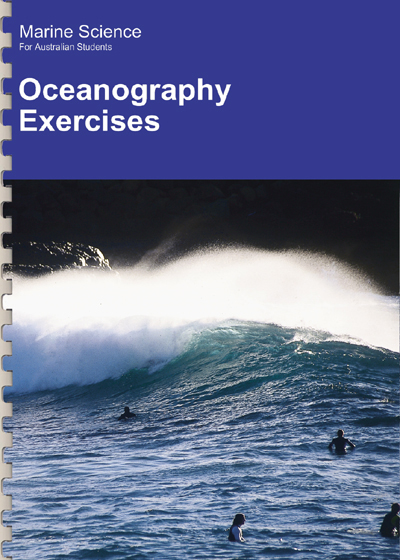Oceanography exercises E Pub

ISBN : 978-1-86283-154-4 (E Pub)
Published Date : 01 January 2025
Product Code : Item 50
Format : Downloadable pdf lifetime licence
Price: $44.00
On Sale: $0.00
By Bob Moffatt
Wet Paper publications non-commercial school licence
The publisher and author/s of this pdf file grant to the school a revocable, non-exclusive, non-transferable right and licence to use the content, exercises, lab and field work lesson notes within the school for educational purposes only.
Yearly record keeping
To ensure fair payment is made to collecting societies, educational institutions are to record the digital ISBN above.
- To do this go to the school office and ask the IT department or whoever looks after digital book licences to record the ISBN in the school digital library licence catalogue.
Copyright
Except as permitted by the Copyright Act 1968 (Cth), you may not reproduce any of the contents of this publication, without the written permission of the copyright owner.
The title to, and intellectual property rests with the publisher's author/s, illustrators, photographers and design consultants and nothing in the agreement should be construed as transferring those rights to the school.
Educational exemption
There are exemptions under the Act that allow educational and government use of text, images and music scores for educational purposes.
These exemptions are in Part VB of the Copyright Act 1968 (Cth), where you are entitled to reproduce or communicate 10% of the words or one chapter from this file for educational use within your school. If you wish to reproduce or communicate MORE than 10% contact the copyright owner.
For more information, see www.copyright.com.au and www.copyright.org.au.
Sample pages
Teachers Information
Copyright
Except as permitted by the Copyright Act 1968 (Cth), you may not reproduce any of the contents of this publication, without the written permission of the copyright owner.
Educational exemption
- There are exemptions under the Act that allow educational and government use of text, images and music scores for educational purposes.
- These exemptions are in Part VB of the Copyright Act 1968 (Cth), where you are entitled to reproduce or communicate 10% of the words or one chapter from this file for educational use within your school. If you wish to reproduce or communicate MORE than 10% contact the copyright owner.
For more information, see www.copyright.com.au and www.copyright.org.au.
Contents
Part A: Oceans
A1. What does the topography of the ocean look like?
A2. What part of the world oceans does Australia own?
A3. What major geological movements have occurred in Australia?
A4. What happened in ice age Australia?
A5. What is climate change and how does it affect the ocean?
A6. How do ocean currents form?
A7. How does the El Niño current affect thermoclines in the sea?
A8. What effect does El Niño cause?
A9. What is so special about the EAC?
A10. What is so special about the Leeuwin current?
A11. When do Australian ocean sea temperatures change?
A12. How is marine life in Australia governed by ocean temperature?
A13. What causes Tsunamis?
Part B: Coastlines
B1. What are some characteristics of waves?
B2. How fast do waves travel?
B3. How does weather affect waves?
B4. What happens when currents approach a shore?
B5. How is sand made and transported in a coastal system?
B6. Why do tides change over the month?
B7. What happens to waves as they approach a beach?
B8. How does sand get onto a beach?
B9. What are sand dunes and how are they made?
B10. Can we classify sand grain sizes found on a beach?
B11. Can we determine the percentage composition of sand on a beach?
B12. How do you draw a beach profile?
B13. How do the dune cycles occur?
B14. What happens when the dune cycle is broken?
B15. When is beach nourishment a solution to coastal management?
B16. Can we make a model to identify coastal ecosystems?
B17. Can we use a template to show wave refraction?
Part C: Seawater and pollution
C1. How much plastic pollution is there in the sea?
C2. How much salt is in seawater?
C3. Can we make and establish a test for seawater?
C4. Can we determine how much oxygen there is in seawater?
C5. What effect does marine pollution have on dolphins?
C6. Why is DDT a problem in the marine food chain?
C7. What are some of our seas contaminated with?
C8. What effect does oil have on feathers?
C9. What happens in an oil spill?
C10. What impact do acid sulfate soils have on the sea?
C11. What effect does water quality have on the marine environment?
C12. How can impacts of coastal development be minimised?
Pages for lab and field work reports



